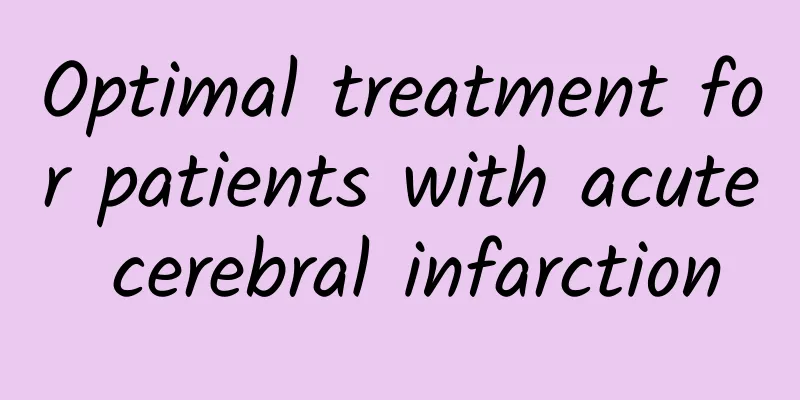Optimal treatment for patients with acute cerebral infarction

|
Acute cerebral infarction is an emergency situation, which is called "stroke" in traditional Chinese medicine. It refers to a brain disease caused by blockage or rupture of cerebral blood vessels. Timely treatment is required after the onset of the disease to protect brain tissue to prevent further damage and increase the patient's chance of survival. Therefore, it is necessary for us to understand the treatment of acute cerebral infarction so that we can understand the various processes when the disease occurs, and allow patients to stabilize their condition and return to normal life earlier. So, for a disease like acute cerebral infarction, how to choose the best treatment method to save patients' lives and reduce the adverse effects of prognosis? This article will introduce some common treatment methods to help you better understand the treatment of acute cerebral infarction. Thrombolytic therapy Thrombolytic therapy is a commonly used method for treating acute cerebral infarction. It dissolves blood clots and restores cerebral blood flow by intravenous injection of thrombolytic drugs. The key to thrombolytic therapy is to be performed within 4.5 hours after onset, so early medical treatment is very important. However, thrombolytic therapy also has certain risks and limitations. Because thrombolytic drugs increase the risk of bleeding, it is necessary to strictly evaluate the patient's condition and contraindications to ensure the safety of treatment. For patients with acute cerebral infarction treated with thrombolytic therapy, cerebrovascular imaging examinations are required to determine whether the patient is suitable for thrombolysis. Commonly used drugs for thrombolytic therapy include tissue plasminogen activator (tPA) and urokinase. These drugs can be injected intravenously into the blood, dissolve blood clots through the blood circulation, and restore cerebral blood flow. Anticoagulation Anticoagulant therapy is also one of the methods for treating acute cerebral infarction. It reduces the risk of cerebral infarction by using anticoagulants to prevent new thrombosis. However, anticoagulant therapy needs to be determined based on the specific situation of the patient. Some patients have bleeding risks or other contraindications and are not suitable for anticoagulant therapy. Antiplatelet therapy Aspirin is a common antiplatelet drug, which has many pharmacological effects such as analgesia, anti-inflammation, and anti-platelet aggregation. After entering the human body, the drug can take effect quickly and effectively prevent cerebral blood vessel blockage. Antiplatelet therapy usually starts in the acute phase, which can reduce the risk of vascular circulation imbalance in patients and can also effectively dilate blood vessels. The viscosity of the patient's blood can be adjusted by inhibiting the selectivity of platelets. Supportive care Supportive treatment is given to patients with acute cerebral infarction, including maintaining the patient's respiratory, circulatory and nutritional status, and preventing complications. Patients with acute cerebral infarction may experience dyspnea and respiratory failure. Supportive treatment can provide oxygen therapy, assisted ventilation, mechanical ventilation, etc. to ensure that the patient's respiratory function is normal. Circulatory support can maintain the patient's blood pressure and hemodynamic stability, including the use of drugs to control blood pressure, maintain blood flow and blood oxygenation. Nutritional support ensures that the patient gets enough nutrition and fluids, which can promote recovery, prevent complications, and adjust the patient's condition through oral or intravenous administration. Supportive treatment can prevent the occurrence of complications such as deep vein thrombosis and lung infection through the use of anticoagulants, early rehabilitation, and active nursing measures. Rehabilitation It is very important for patients with cerebral infarction to undergo rehabilitation treatment. Rehabilitation treatment includes physical therapy, speech therapy, occupational therapy, etc., which can help patients restore body functions. Physical therapy can help restore muscle strength, balance and coordination. Patients can regain the ability to walk and carry out daily activities through muscle exercise, balance training, gait training, etc. Speech therapy is aimed at patients with language disorders and dysphagia, and restores language ability and swallowing function through language training, pronunciation practice, language comprehension training and other methods. Occupational therapy helps patients relearn various activities in daily life, improve their self-care ability, work skills, social skills, etc., and help them reintegrate into social life and work. Because rehabilitation treatment is a long-term process, patients and their families need to actively participate in achieving rehabilitation goals. However, the effect of rehabilitation treatment varies from person to person. Through continuous efforts and professional guidance, patients can achieve a certain degree of functional recovery, thereby improving the quality of daily life. Conclusion: Common treatments for acute cerebral infarction include thrombolytic therapy, angioplasty, anticoagulation therapy, antiplatelet therapy, supportive therapy and rehabilitation therapy. However, the best treatment plan should be formulated according to the patient's specific situation. Early diagnosis and emergency treatment are crucial for patients with acute cerebral infarction. Reasonable treatment and rehabilitation measures can help patients restore function. Please remember that early treatment of acute cerebral infarction is the key, and timely treatment within the golden time window can achieve a good prognosis. Prevention of cerebral infarction is more important than treatment! Pay attention to cerebrovascular health in daily life, perform cerebrovascular examinations regularly, accurately control cerebrovascular conditions, and intervene in time to prevent problems before they occur! Author: Shi Jing, Xingtai General Hospital of North China Medical Health Group |
<<: Do you know about Parkinson's disease medication? | Science Time
>>: Seriously, stop using plastic bottles!
Recommend
What are the dangers of having a hysterectomy?
Every woman knows that uterine health is directly...
How to drive in the rain during a typhoon? Do you need to turn on the fog lights when driving in the rain?
Typhoons are common natural weather. Severe typho...
What should women eat to enhance sexual function?
Although in the eyes of many people, it seems tha...
Irregular abdominal pain at 39 weeks of pregnancy
If you experience irregular abdominal pain at 39 ...
Women over 30 are very likely to develop this cancer
Women over 30 are more likely to develop various ...
Private itching, odor, abnormal vaginal discharge
The private parts of female friends must be prope...
What should I do if my ears hurt after wearing a mask for a long time? What props should I use to solve the problem of ear pain after wearing a mask for a long time?
We all know that masks are a common type of prote...
What are the symptoms and treatment of Chlamydia vaginitis?
Vaginitis is currently the most common gynecologi...
Why do I have stomach pain after sex?
Men and women are usually very happy and relaxed ...
Can I still get pregnant if I have ovulation bleeding?
Ovulation bleeding is not common among modern wom...
Signs of menstruation coming soon during lactation
After giving birth, women will have a period of u...
What are the symptoms of pregnancy at the beginning?
What are the symptoms of being pregnant for one o...
How to treat mild breast hyperplasia
The incidence of problems such as breast hyperpla...
What to do if breast milk swells and hurts after a normal birth
Natural birth is the best way of childbirth, beca...









